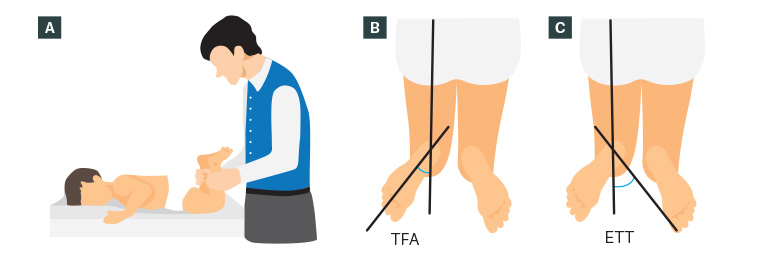
Rotational Deformities in Children
Overview
Rotational deformities in children are conditions in which the bones in the legs or arms are twisted or misaligned. These deformities can occur in one or multiple parts of the limb, making it difficult for children to walk or use their hands properly. While it is relatively common and often outgrown during childhood, persistent or severe cases might require medical attention.
Types
The commonly recognized types of rotational deformities are:
– Femoral Anteversion: Here, the femur (thigh bone) has an exaggerated inward twist.
– Tibial Torsion: This involves an unusual twist in the tibia, or the shinbone.
– Internal or External Hip Rotation: This is a condition where the hips turn inwards or outwards more than they should.
– Metatarsus Adductus: This is a foot deformity where the front half of the foot, or forefoot, turns inward.
Causes
Rotational deformities are usually congenital, meaning children are born with them. This can happen due to the child’s position in the uterus. Other causes could be:
– Differences in growth rates between different parts of the limb.
- Trauma or fractures to the limb.
– Neuromuscular disorders, such as cerebral palsy.
Symptoms
Symptoms depend on the type and severity of the deformity, but often include:
– Difficulty in walking or running.
- The child might walk on their toes.
– The child’s knees or feet might point inward or outward.
– Uneven wear on the shoes.
Diagnosis
Diagnostic processes include:
– Detailed medical history: This includes understanding any family history or conditions.
– Physical examination: Doctors will observe the child’s gait and joint flexibility.
– Imaging tests: X-rays, MRI, or CT scan might be used to identify the extent of the deformity.
Treatment Options
Treatment usually depends on the type and severity of the deformity. Conservative treatment options include:
– Observation: Mild deformities usually self-correct as the child grows.
– Physical therapy: Certain exercises could help increase range of motion.
– Bracing: Special shoes or casts can be used to correct the alignment.
In severe or persistent cases, surgical intervention might be necessary.
Living With Rotational Deformities in Children
Living with rotational deformities can be challenging but it’s manageable through certain initiatives:
– Regular follow-ups with the doctor.
– Encourage physical activities to promote muscle strength and flexibility.
- Ensure wearing recommended braces or special footwear.
When to Seek Help
Immediate medical attention is advised when:
– There’s severe pain accompanied with the deformity.
– Reduced mobility or limited range of motion.
– If there’s no improvement with conservative treatment.
Noticeably, if your child’s ability to perform day-to-day activities is hampered, it’s essential to get it checked. Rotational Deformities, though common in children, should be observed and managed properly to ensure appropriate growth and mobility.
